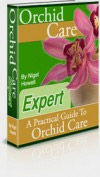Orchids are my favourite house plant and indeed many other peoples too. They’ve gained in popularity hugely in recent years and for good reason. There are many varieties and species around, from the many naturally occurring species, to an ever increasing number of hybrid varieties. Contrary to popular belief they are really not that difficult to grow and look after either. With a little care and knowledge anyone can keep a beautiful, healthy orchid in almost any home environment.
Environments
Orchid requirements are simple and not much different to many other houseplants, water, light fertilizer and temperature are all simple factors that you can control with the proper understanding of your orchid species. For example, some orchids will thrive in cooler environments whilst others prefer temperatures around 80 degrees Fahrenheit (27 degrees Celsius).
Understandably it is far easier to select your species of orchid based on the environment you will be growing it in. Perhaps the easiest and most adaptable species is the Phalaenopsis orchids. The Phalaenopsis orchid will grow well in an indoor home or office environment and produces long lasting blooms, making it a popular choice for first time growers.
Blooms
Flowering time depends a lot on the species of orchid itself, the Phalaenopsis species for example will remain in bloom for two to three months from the time the first buds open. Compared to the Cattleyas species of orchid which may only flower for a month. Some species may flower only once in a year while others may have several blooms throughout and there are others that will flower all year round.
Making Scents
Another important reason that orchid popularity is increasing is down to their fragrance. Some varieties can be strongly scented whereas other orchids are far more subtle in their fragrance. The strength and scent varies greatly between species, from subtle to strong, flowery to fruity. One of the more remarkable things about these plants is that some species can produce wonderfully familiar scents like raspberry, coconut, citrus, lilac or in some cases even chocolate.
Potting
Bark is the preferred potting medium for orchids rather than soil, they may also thrive when grown in New Zealand Sphagnum Moss. The reason being that they require very good drainage and air circulation around the roots therefore they should also be grown in pots that assist in this process. Standard potting soil is not adequate for the job.
Your orchids should be watered sparingly, once or twice every couple of weeks and slightly more frequently during hot months. If you’ve chosen to plant your orchid in New Zealand Sphagnum Moss then they will require watering less often than if you are using bark. Once every seven to ten days should be adequate.
Lighting
Orchids are naturally found in tropical areas of the world and therefore receive plenty of both light and shade, long periods of sunlight that not too strong. I’ve found they do well sitting near an Eastern facing window.
A common symptom of over exposure to strong sunlight is a yellowing of the leaves. If you find this is happening to your orchid you should try to provide a little more shade for it. Yellowing of the leaves is also a side effect of under feeding, your orchid requires fertilizer roughly once every two weeks should be adequate. You can buy specialist orchid fertilizer from most local garden centres. Use a diluted solution and if the potting media is dry then don’t forget to water your orchid before feeding it.

